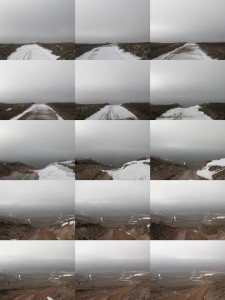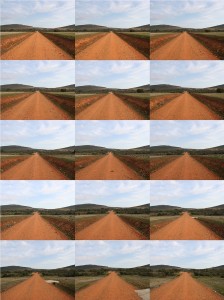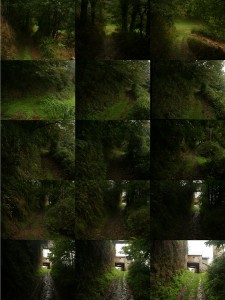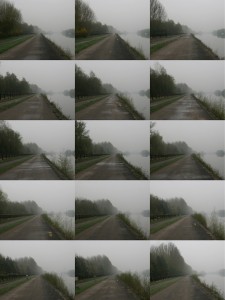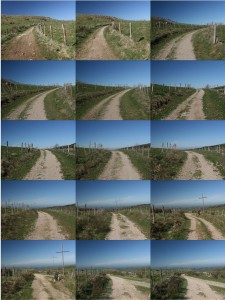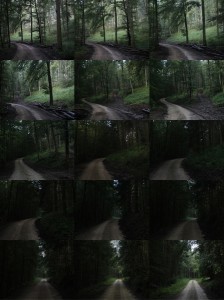La búsqueda de lo espiritual al margen de lo religioso es una constante en el arte que se manifiesta bajo muy diferentes aspectos: ya sea desde esta búsqueda de lo invisible, desde la obtención de lo abstracto, desde lo poético entendido como ambiente, o ese intento conceptual… creo que es en la peregrinación donde este fenómeno aúna por fin lo físico y lo espiritual.
La peregrinación budista se caracteriza en cuanto a su estructura por ser una circunvalación a un lugar siempre presente. En el caso de la peregrinación a Santiago, llegar al lugar, a Santiago, significa sin embargo haber finalizado la peregrinación, su linealidad hace que dicho lugar sea ausente hasta su culminación. La forma de caminar en círculo o en línea representa y distingue dos mentalidades, dos estructuras y dos modos de vida.
El intento de comparar y contrastar estas dos formas de ver tan diferentes y poder extraer algo en claro de todo ello, es lo que me hizo considerar un posible trabajo sobre el Camino de Santiago. Dado que el tema del Camino francés estaba ya muy trillado y que venía de paisajes totalmente vírgenes en Tíbet, me interesó en un principio todo aquello que nunca se había mostrado: su camino.
Desde esta perspectiva del lugar, el Camino de Santiago al ser entendido como una entidad propia, como algo que existe al margen o separado de Santiago hizo de él que lo considerase un lugar de la mente. Un lugar que deviene de otro y que contrario al lugar físico, se caracteriza por todos los opuestos a lo que entendemos normalmente por lugar. Frente a lo concreto y lo estable, es un continuo cambio. Esta noción de lugar inasible, de transito perpetuo y sin embargo concreto, como lapsus, es la que me llevó a la necesidad de desdoble en una trilogía que llamé “Tres caminos, 11 pasos”.

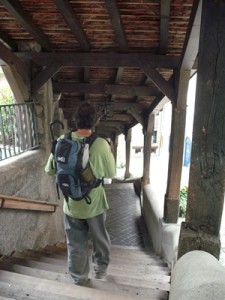
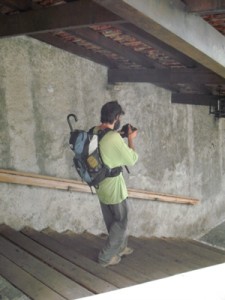
La duración de estos vídeos, entre 4 y 7 horas y media, no sólo hablan de caminos que son trayectos de largo recorrido. Para mí, sobre todo, habla de una forma de abordar el tema de lo invisible. No creo que vaya a haber nadie que vea esta obra completamente, sin embargo ahí está. También la ausencia de sonido me parecía interesante en contraposición a la saturación de la imagen.
Han sido en total 6 años de trabajo intenso en los que andar y fotografiar es lo más fácil de todo el trabajo y de todo el proceso. Hay que pensar que luego todas esas cientos de miles de fotos hay que ir montándolas una a una, encuadrándolas para que la imagen en el espectador sea lo más fluida posible. Hay que ir cambiando los ángulos, hay que ir cambiando las horizontales, las verticales, es un trabajo bastante arduo y minucioso en el que no se llega a editar más de cuatro minutos al día.
Respecto a la obra en sí, a su emoción estética, creo que estos pequeños hachazos que consisten en las fotografías y las transiciones que utilizo en las que las imágenes van surgiendo y disolviéndose al mismo tiempo a un ritmo que es rápido pero constante hace de ello algo hipnótico, que te atrapa si te dejas llevar.
The choice of documentary form is in fact a product of the respect imposed by these special, holy places in which everything already exists and there is no need to add or manipulate anything.
It all started with the journey round Mount Kailash. I was looking for a special place and Mount Kailash could be regarded as the most sacred of all the planet’s natural sites. The mountain indeed stands as one of those places whose body or essence is consubstantial with its appearance. This journey was also my initiation in the “stop motion” technique of photographic animation, which I have retained here to give the series a sense of unity, a solid entity albeit with differing characteristics.
The quest for spirituality free of religious connotations is a constant in art that is expressed today under diverse guises, be it the pursuit of the invisible, the achievement of abstraction, the life poetic, conceptual striving… and I believe that the pilgrimage is where the physical and spiritual sides of this phenomenon finally come together.
The Buddhist pilgrimage has the structural peculiarity of being a journey round an ever present place. But in the case of the pilgrimage to Santiago, arriving there, in Santiago, means the pilgrimage is over, the route’s linear nature means the place is absent until its culmination. Walking in a circle or in a line represents and distinguishes two different mentalities, two structures and ways of life.
The attempt to compare and contrast these two very different ways of seeing and extract some kind of message is what made me consider undertaking a project around St James’s Way. Since the theme of the French Way was already overworked, and I was arriving fresh from unspoilt regions in Tibet, what first caught my interest was what had never been shown: the actual way.
From this standpoint, St James’s Way, seen as a thing in itself, separate from the town of Santiago, became transformed into a place of the mind. A place that derives from another and is characterised, unlike the physical place, by the opposites of what we normally understand as a place. A constantly unfolding change as opposed to something concrete and stable. This idea of an ungraspable place of perpetual yet tangible movement, like a lapse in time, is what led me to the vehicle of the trilogy, the result being “Three ways, eleven steps”.
The duration of the videos, between four and seven-and-a-half hours, refers not only to the fact that these are long-distance routes. For me, it is also about approaching the subject of invisibility. I don’t think anyone will watch the whole of this piece, yet there it is. I also liked the idea of the absence of sound contrasting with the saturation of images.
Enlarging the routes to Europe was a commission from Fundación Arq Art which proposed the videos’ simultaneous projection as a discrete artistic event. I decided to fulfil the commission by creating a new trilogy along the lines of the first, in view of Europe’s importance in the history of St James’s Way.
In all, it has taken three years of intense work in which the actual walking and taking photographs was the easiest part of the process. Remember that these hundreds of thousands of photos then have to be assembled one by one, framed in such a way that what the spectator sees is as fluid as possible. This means changing the angles, the horizontals and verticals in a painstaking process where it is impossible to edit more than four minutes’ worth a day.
As to the work in itself and its aesthetic emotion, I believe the subtle cleavings that are the photographs themselves and the transitions I employ, with the images appearing and dissolving in a fast but constant rhythm, create something hypnotic that will pull you in if you surrender to it.
VIDEOS «TRES CAMINOS, ONCE PASOS»
